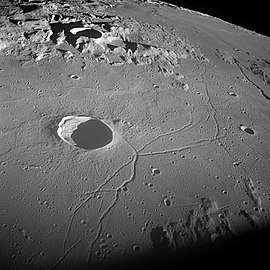Triesnecker (crater)
Triesnecker is a prominent lunar impact crater that is located in the Sinus Medii, near the central part of the Moon's near side. Its diameter is 25 km. It was named after Austrian astronomer Franz de Paula Triesnecker.[1] It is located to the north-northwest of the crater Rhaeticus, and to the east-southeast of the flooded Murchison.
 Lunar Orbiter 4 image of Triesnecker crater and the Rille systerm | |
| Coordinates | 4.18°N 3.60°E |
|---|---|
| Diameter | 25 km |
| Depth | 2.8 km |
| Colongitude | 356° at sunrise |
| Eponym | Franz de Paula Triesnecker |
The crater rim of Triesnecker is somewhat distorted from a circular shape, having a notable bulge in the western wall, and lesser rises in the southeastern and northeastern rims. The inner walls are terraced and the interior is somewhat rough, with a central peak at the midpoint. Triesnecker has a ray system that is most prominent when the sun is at a high angle. The rays extend over 300 kilometers.
To the east of this crater is an extensive system of rilles extending over an area 200 kilometers across, running generally north–south. These were likely created by tectonic forces beneath the surface. Beyond, to the northeast, is the Rima Hyginus valley, with the crater Hyginus at the midpoint.
Satellite craters

By convention these features are identified on lunar maps by placing the letter on the side of the crater midpoint that is closest to Triesnecker.

| Triesnecker | Latitude | Longitude | Diameter |
|---|---|---|---|
| D | 3.5° N | 6.0° E | 6 km |
| E | 5.6° N | 2.5° E | 5 km |
| F | 4.1° N | 4.8° E | 4 km |
| G | 3.7° N | 5.2° E | 3 km |
| H | 3.3° N | 2.8° E | 3 km |
| J | 3.3° N | 2.5° E | 3 km |
References
- "Triesnecker (crater)". Gazetteer of Planetary Nomenclature. USGS Astrogeology Research Program.
- Andersson, L. E.; Whitaker, E. A. (1982). NASA Catalogue of Lunar Nomenclature. NASA RP-1097.CS1 maint: ref=harv (link)
- Bussey, B.; Spudis, P. (2004). The Clementine Atlas of the Moon. New York: Cambridge University Press. ISBN 978-0-521-81528-4.CS1 maint: ref=harv (link)
- Cocks, Elijah E.; Cocks, Josiah C. (1995). Who's Who on the Moon: A Biographical Dictionary of Lunar Nomenclature. Tudor Publishers. ISBN 978-0-936389-27-1.CS1 maint: ref=harv (link)
- McDowell, Jonathan (July 15, 2007). "Lunar Nomenclature". Jonathan's Space Report. Retrieved 2007-10-24.CS1 maint: ref=harv (link)
- Menzel, D. H.; Minnaert, M.; Levin, B.; Dollfus, A.; Bell, B. (1971). "Report on Lunar Nomenclature by the Working Group of Commission 17 of the IAU". Space Science Reviews. 12 (2): 136–186. Bibcode:1971SSRv...12..136M. doi:10.1007/BF00171763.CS1 maint: ref=harv (link)
- Moore, Patrick (2001). On the Moon. Sterling Publishing Co. ISBN 978-0-304-35469-6.CS1 maint: ref=harv (link)
- Price, Fred W. (1988). The Moon Observer's Handbook. Cambridge University Press. ISBN 978-0-521-33500-3.CS1 maint: ref=harv (link)
- Rükl, Antonín (1990). Atlas of the Moon. Kalmbach Books. ISBN 978-0-913135-17-4.CS1 maint: ref=harv (link)
- Webb, Rev. T. W. (1962). Celestial Objects for Common Telescopes (6th revised ed.). Dover. ISBN 978-0-486-20917-3.CS1 maint: ref=harv (link)
- Whitaker, Ewen A. (1999). Mapping and Naming the Moon. Cambridge University Press. ISBN 978-0-521-62248-6.CS1 maint: ref=harv (link)
- Wlasuk, Peter T. (2000). Observing the Moon. Springer. ISBN 978-1-85233-193-1.CS1 maint: ref=harv (link)
External links
| Wikimedia Commons has media related to Triesnecker (crater). |
| Wikimedia Commons has media related to Rimae Triesnecker. |
- Triesnecker at the Moon Wiki
- Rimae Triesnecker at the Moon Wiki
- Lunar Orbiter 2 Closeup of Rimae Triesnecker (Lunar and Planetary Institute)
Related articles
- Wood, Chuck (May 26, 2004). "Triesnecker Rilles". Lunar Photo of the Day. - only the rille
- Wood, Chuck (July 25, 2004). "Pre-History of the Triesnecker Area". Lunar Photo of the Day. Retrieved August 7, 2017.
- Wood, Chuck (September 23, 2004). "Lunar Crater Types". Lunar Photo of the Day. - one of the craters depicts Triesnecker
- Wood, Chuck (February 2, 2006). "100 Minute Drawing". Lunar Photo of the Day. Archived from the original on September 16, 2017. - only the rille
- Wood, Chuck (November 3, 2006). "Continuing East". Lunar Photo of the Day. Archived from the original on August 7, 2017. - both the crater and the rille
- Wood, Chuck (November 4, 2006). "Digging Below the Surface". Lunar Photo of the Day. Archived from the original on August 7, 2017.
- Wood, Chuck (October 19, 2007). "Troughful Magnificence". Lunar Photo of the Day. Archived from the original on August 7, 2017. - both the crater and the rille
- Wood, Chuck (May 5, 2009). "Two Views". Lunar Photo of the Day. Retrieved August 7, 2017.